Understanding the Appearance of Meteorites


Intro
When stepping outside, one may gaze up at the night sky and contemplate the vast universe. Among the countless celestial bodies, meteorites hold a special allure for collectors and enthusiasts alike. These ancient travelers carry stories from the far reaches of space, but what sets them apart is not just their origin; it's their unique appearances and properties that intrigue us. Understanding the physical characteristics of meteorites is essential for distinguishing them from regular rocks found on Earth.
In this guide, we will dive into the fascinating aspects of meteorite appearance, including textures, colors, and classifications. We'll also discuss practical identification techniques and resources to aid in the journey of collecting these cosmic treasures.
Featured Collectible of the Month
Overview
This month’s spotlight is on the Murchison meteorite, a well-known carbonaceous chondrite that fell in Australia in 1969. The Murchison meteorite not only captivates collectors with its unique aesthetics, but it also plays a crucial role in our understanding of organic compounds in space. With its dark, often rough exterior, this meteorite exhibits a variety of textures, primarily due to its rich mineral content.
Historical Significance
The Murchison meteorite is more than just a pretty rock; it's a scientific marvel. It is believed to contain amino acids and other organic compounds that are pivotal for the study of the origins of life. Its fall was also extremely well-documented, allowing scientists a clear timeline and context for analysis. Collectors often seek it out not only for its visual attributes but also for its historical and scientific value.
Identification Techniques
Identifying meteorites can be quite an adventure, and with the right techniques, you’ll feel more confident in your quest. Here are some noteworthy methods:
Visual Characteristics
When spotting a potential meteorite, pay attention to certain features:
- Fusion crust: A thin, shiny black or dark brown coating formed during its fiery entry into Earth's atmosphere.
- Regmaglypts: Indentations or thumbprint-like marks on the surface, revealing its passage through the atmosphere.
- Metallic flakes: Some meteorites, especially iron types, may showcase metallic glitter within a predominantly stone-like matrix.
- Weight: Meteorites are often more dense than Earth rocks; a decent test is to heft it in hand.
Resources for Identification
While hands-on examination is vital, having a few reliable resources can be a game-changer:
- MeteoriteIdentification.com: A comprehensive guide for beginners, packed with visuals and descriptions.
- Wikipedia and Britannica: These provide in-depth historical and scientific context, perfect for any enriched discussion.
- Online Forums: Communities on platforms like Reddit can offer advice, share experiences, and assist with identification.
"The difference between a rock and a meteorite can sometimes come down to a matter of perspective. Discerning the nuances is part of the joy in collecting."
The Basics of Meteorites
Understanding meteorites serves as the foundation for anyone interested in their appearance and characteristics. These visitors from space bring with them fascinating tales and secrets about the universe. By grasping the basics, enthusiasts and collectors can enhance their knowledge and appreciation of these celestial objects.
Definition and Origin
Meteorites are solid fragments resulting from meteoroids that survive their fiery passage through Earth’s atmosphere. A meteoroid is a rocky or metallic object in space; once it enters the atmosphere and creates that bright streak we sometimes see at night, it becomes a meteor. If this burning object manages to reach the ground without completely disintegrating, it qualifies as a meteorite.
Origin-wise, meteorites originate from several potential sources, such as the Moon, Mars, or asteroids, particularly the asteroid belt between Mars and Jupiter. Each category—whether stony, iron, or stony-iron—holds clues about its background and can reveal a wealth of information regarding the solar system's formation and evolution.
Meteorites have an intriguing journey before they land on our planet. They can originate from ancient celestial bodies that existed long before life began on Earth, lending insights into the building blocks of our own planet.
Historical Context
The historical narrative surrounding meteorites is as rich as the science behind them. Ancient civilizations documented meteorite falls and viewed them as omens or divine messages. For instance, the Greeks believed that meteorites were stones sent by the gods. Early records, such as the fall of a meteorite in 1492 over the town of Ensisheim in France, fascinated people and prompted discussions about the nature of these objects.
In more modern times, scientific inquiry into meteorites intensified during the 19th century. Collecting meteorites became a trend among scientists. Numerous falls were documented, leading to systematic classification based on their composition. This timeline showcases humanity's evolving understanding of meteorites—ties between them and the queries revolving around the cosmos have only increased with time.
In summary, understanding meteorites involves more than just recognizing their physical attributes. It encompasses their origins, historical significance, and the valuable insights they provide about our universe. For rock and fossil collectors, this knowledge is not just a trivial pursuit; it’s an essential aspect of handling these awe-inspiring objects.
Physical Characteristics of Meteorites
Understanding the physical characteristics of meteorites is crucial for collectors, researchers, and enthusiasts alike. The ability to discern the various aspects of these celestial objects informs the identification process and adds to the appreciation of their uniqueness. Meteorites possess a myriad of features that distinguish them from regular Earth rocks; each characteristic carries with it insights into the meteorite's origin and history. Knowing how to recognize these traits can empower collectors in their pursuits and enhance the scientific dialogue surrounding these spaceborne materials.
General Appearance
The general appearance of a meteorite can range dramatically, from smooth and shiny surfaces to rough and pitted textures. These appearances stem from their journey through space and entry into the Earth's atmosphere. Observers often note that meteorites may present with an exterior that showcases a dull, rocky finish, or alternatively, a lustrous, glossy look that captures light brilliantly. When inspecting a meteorite, certain visual cues can be pivotal:
- Shape: Most meteorites exhibit irregular shapes, due to fracturing or the often violent collision they experienced.
- Color: Colors can vary widely; some meteorites appear in hues of gray or brown, while others might display striking metallic glimmers.
- Weight: Meteorites are typically denser than regular rocks of a similar size, a clue that can substantiate identification.
Surface Texture
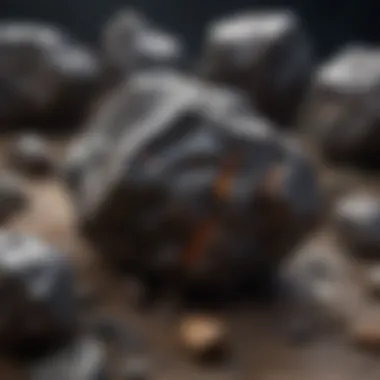
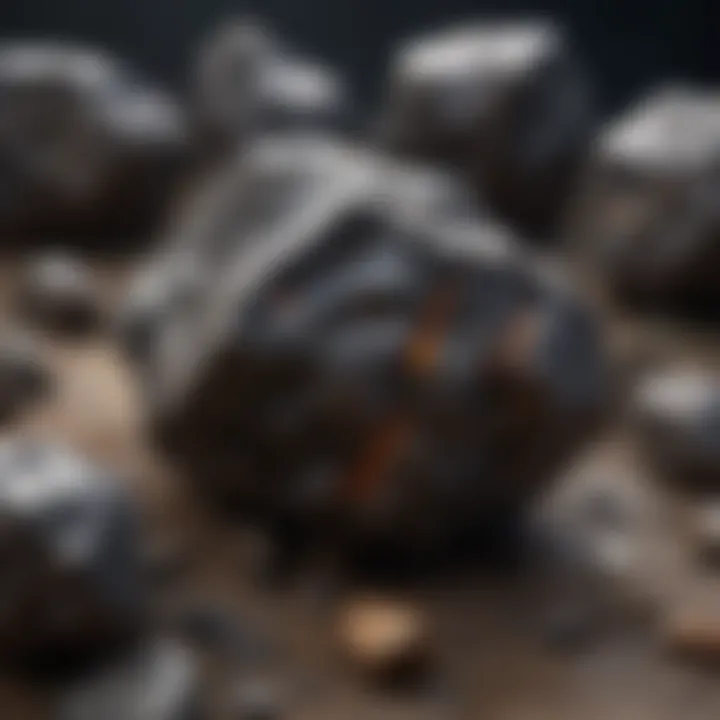
Surface texture is a fascinating aspect of meteorites, revealing details about their formation and entrance into Earth's atmosphere. A meteorite’s texture can be divided into several categories:
- Fusion Crust: When a meteorite enters the atmosphere, the intense heat causes its outer layer to melt, resulting in a thin, shiny crust.
- Pitting or Abalation: Many meteorites show signs of pitting or ablation, where fragments have been stripped away during atmospheric entry. These textures can give the meteorite a unique fingerprint that aids in classification.
- Metallic Features: Some meteorites, particularly iron meteorites, reveal metallic or crystalline textures on their surfaces, attributed to the high nickel-iron content. This texture not only enhances their aesthetic appeal but also serves as a valuable identifier for collectors.
Examining the surface texture allows collectors and enthusiasts to develop a deeper understanding of not only the meteorite itself but also its history and journey through space.
Size Variations
Size is another noteworthy characteristic of meteorites, with variations that can be astonishing. Meteorites can range from tiny particles, often referred to as micrometeorites, to massive boulders weighing tons. A few important considerations include:
- Common Sizes: The typical size for a meteorite often falls between the dimensions of a marble and a grapefruit, making them relatively easy to handle.
- Notable Examples: Some of the most famous meteorites, like the Hoba meteorite from Namibia, weigh over 60 tons and are a popular point of interest for tourists and scientists alike.
- Contextual Influences: The size of a meteorite can influence not just its collectability but also how it is viewed in the scientific community. Larger specimens may yield more data during analysis, but even small samples can significantly contribute to research.
"Meteorites remind us of the vast universe we are a part of, each with a story to tell, waiting to be uncovered."
Classification of Meteorites
Classifying meteorites is essential for both scientific inquiry and the hobbyist's collection endeavor. By grouping these celestial samples into specific categories, researchers can better understand their origins, compositions, and the processes that led to their formation. For collectors, acquiring a well-documented meteorite that falls into a specific classification not only enhances the value of their collection but also enriches the story behind each piece.
Knowing how meteorites are classified can assist in distinguishing them from ordinary terrestrial rocks, thus making identification easier and more accurate. Understanding the nuances of each type helps collectors decide what to look for when expanding their collection, whether it be for scientific reasons or personal interest.
Stony Meteorites
Stony meteorites are the most numerous variety found on Earth. They primarily consist of silicate minerals, which are similar to those found in our planet's crust. Their composition often includes olivine, pyroxene, and feldspar, giving them a somewhat familiar appearance. These meteorites can be further divided into two categories:
- Chondrites: These meteorites contain small, round grains called chondrules formed in the solar nebula. Their often dull exterior may mislead the casual observer, concealing a world of intricacies within.
- Achondrites: Lacking the round chondrules found in chondrites, achondrites resemble terrestrial rocks more closely. They usually originate from differentiated parent bodies, like asteroids, which have undergone significant geological alteration.
Collectors often favor stony meteorites due to their relative abundance, and their geological similarities to Earth rocks. Just touching one can ignite a sense of connection with the cosmos, despite its ordinary exterior.
Iron Meteorites
Iron meteorites are distinctly different from their stony counterparts, as they are composed primarily of metal—mostly iron and nickel. Their unique metallic luster often catches the eye, making these specimens popular among collectors. Iron meteorites are believed to originate from the cores of differentiated asteroids, which have gone through drastic metamorphosis over eons.
There are two main classifications of iron meteorites:
- Coarse Octahedrites: These display a crystalline structure resembling a honeycomb when cut and polished, resulting in stunning patterns that captivate even the most seasoned collectors.
- Widmanstätten Pattern: This intricate pattern forms due to the slow cooling of iron in space, which poses an eternal challenge for metallurgists even today. Seeing this pattern in a specimen is like finding a hidden treasure.
Their resilience and unique appearance offer a contrast to stony meteorites, making iron meteorites both a striking and scientifically significant addition to any collection.
Stony-Iron Meteorites
Stony-iron meteorites are the intriguing hybrids of the meteorite world. They represent a blend of both metal and rock, showcasing the diversity of materials that can come together through the processes of cosmic formation. Their characteristics can vary significantly, leading to two important categories:
- Pallasites: These contain olivine crystals embedded within a nickel-iron matrix. Their translucent yellow-green crystals create a window to the cosmos that intertwines beauty and rarity, making them a coveted prize.
- Mesosiderites: These consist of a more equal blend of metal and silicate material. Their appearance often yields a more rugged texture but offers a robust narrative of the meteorite's tumultuous journey through space and time.
Collectors who manage to obtain stony-iron meteorites will find that they’re not just adding a rare specimen—they are acquiring a piece of a compelling story, capturing two worlds in one specimen.
Understanding the classification of meteorites not only aids passionate collectors but also enriches scientific discussions, allowing us to fathom the rich tapestry of the universe.
Color and Composition
When discussing meteorites, the aspects of color and composition are quite vital. They provide not just a superficial glance but also reveal the intricate details about the meteoroid’s journey through space and its ultimate transformation upon entering Earth’s atmosphere. Understanding these elements allows collectors and enthusiasts to better identify meteorites and appreciate their uniqueness.
The interplay of different minerals contributes significantly to the color palette exhibited by these celestial bodies. By examining the mineral makeup of meteorites, collectors gain insights into their origin and the conditions under which they formed. Different meteorite types and their characteristics yield clues that can help differentiate them from ordinary Earthly rocks.
Mineral Content
Meteorites are primarily categorized based on their mineral components, which paint a vivid picture of their journey through the solar system. The principal minerals found in meteorites include olivine, pyroxene, and plagioclase. These specific minerals not only emerge during rare cosmic events but also hold tales of their past intertwined in their internal makeup.
- Olivine: Often green and glassy, olivine indicates high temperatures during formation.
- Pyroxene: Typically darker, pyroxene can signal volcanic activity.
- Plagioclase: This mineral adds a white or cream hue, often reflecting a more chilled historical narrative.
Meteorite samples rich in these minerals can exhibit significant differences in appearance. For instance, the presence of olivine may create a gem-like sparkle, while a predominately pyroxene-rich meteorite will appear more subdued.
Additionally, meteorites can carry unique isotopic signatures that unveil their craftsmanship in the primal solar nebula. These compositions underline the extraordinary diversity of meteoritic materials, making each specimen a window into the universe’s history.
Chromatic Variations
The colors in meteorites are not merely for eye-catching effect; they translate directly to their origins and the processes that shaped them. Chromatic variations can result from a myriad of factors ranging from their elemental blend to the effects of atmospheric entry.
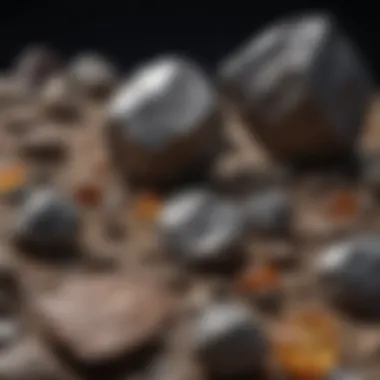
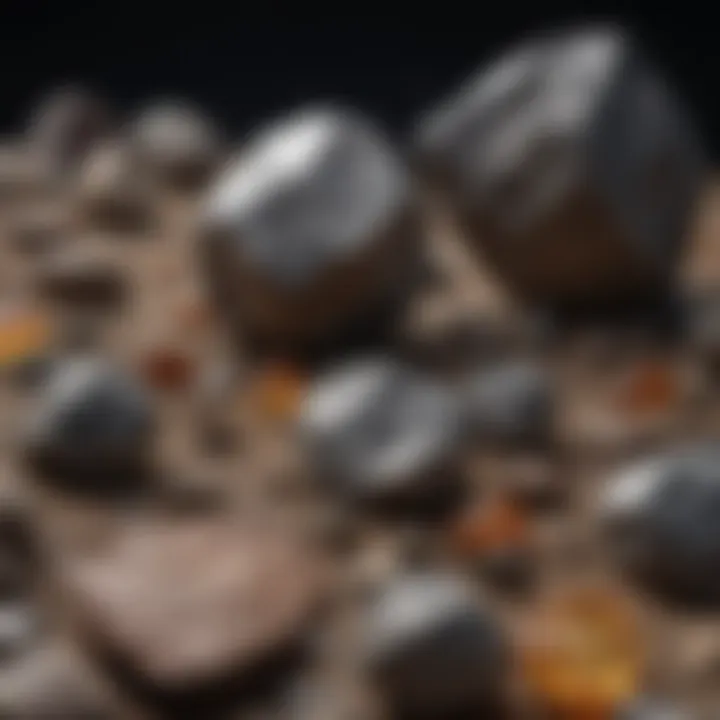
For example, some meteorites display a rich, rusty red hue due to the oxidation of iron present in their structure. Meanwhile, others may shine with metallic brilliance depending on their iron-nickel content.
These are some factors that influence color:
- Oxidation: Chemical reactions with atmospheric oxygen can lead to rust-like appearances.
- Mineralization: Unique minerals can bestow colors such as yellow or blue, each telling a different tale.
- Surface Interaction: Space weathering can modify a meteorite’s surface, imparting a patina or color shift.
"Each meteorite can be considered a crafted object made by cosmic processes, where its colors, forms, and textures serve as a narrative, guiding the curious towards deeper understanding."
Understanding the colors and mineral content in meteorites enriches the experience for rock and fossil collectors. Not only does it assist in identification, but it also deepens the appreciation of these ancient fragments from beyond our planet. With every hue and texture decoded, we connect more profoundly to the cosmos.
Impact of Atmospheric Entry
The journey of a meteorite from the vastness of space to the surface of Earth is nothing short of intriguing. Among the various factors that influence its final appearance, the impact of atmospheric entry plays a pivotal role. This section delves into the critical elements of ablation effects and fusion crust formation that transform these celestial bodies into unique specimens. Understanding these effects adds substance to the appreciation of meteorites for both collectors and enthusiasts.
Ablation Effects
When a meteorite hurtles through the atmosphere, it faces a barrage of challenges that test its integrity. The process known as ablation refers to the removal of material from the surface of the meteorite, primarily due to intense heat and friction. As it descends at breathtaking speeds, the external layers are stripped away, resulting in significant alterations to its original form.
- Temperature Changes: The extreme temperatures can soar above 1,600 degrees Celsius, causing volatile compounds in the meteorite to vaporize or break down.
- Mass Loss: A notable portion of the meteorite is often lost during this fiery descent, making the specimen that eventually lands different in size and shape than when it was in space.
- Surface Alterations: The relentless heating can lead to the formation of a smooth, shiny surface, which is known as a weathered patina, marking a clear distinction between its pre- and post-atmospheric appearance.
This erosion not only serves as a marker of identity, it also gives clues about the meteorite's origin and its history. Knowing how ablation affects meteorites can equip collectors with the skills to assess the physical characteristics that speak to the rock's journey.
Fusion Crust Formation
As meteorites blaze through the atmosphere, fusion crust formation becomes evident. This phenomenon results from the intense heat generated during atmospheric entry, causing the outermost layer of the meteorite to melt. The subsequent cooling creates a thin, glassy coating on the surface called the fusion crust, and it can be a phenomenal indicator for identification.
- Visual Traits: Fusion crust often appears dark, with a glassy, shiny texture, and might feature subtle variations in color, dependent on the composition of the meteorite. Ranging from black to a deep reddish-brown, the colors can tell a tale of the elements found within.
- Textural and Thickness Variations: Not every meteorite will exhibit a uniform fusion crust. Some may have a barely noticeable film, while others show a thick, rugged exterior. This disparity often corresponds to the size and speed at which the meteorite entered the atmospheric sphere.
- Chemical Signatures: The analysis of fusion crust can reveal vital clues about the composition and history of the meteorite itself. The interaction of different elements at high temperatures can create unique chemical signatures that are worth studying further.
Fusion crust is not merely a protective layer; it is a narrative of survival against the odds, featuring the scars of atmospheric entry etched into its surface.
For collectors, recognizing and understanding the characteristics of fusion crust can provide insight into the meteorite's journey. This knowledge fortifies their prowess in identifying authentic specimens amidst terrestrial rocks, enhancing the value and prestige of their collection.
Grasping the significance of atmospheric entry is imperative for anyone serious about meteorite collecting. With the processes of ablation and fusion crust in mind, one gains a deeper appreciation for these celestial fragments and the stories they carry.
Identifying Meteorites
Identifying meteorites stands as a crucial element in our quest to understand these celestial rocks that have traversed vast distances through space before reaching Earth. For both enthusiasts and seasoned collectors, distinguishing meteorites from ordinary terrestrial stones is fundamental not only for value assessment but also for scientific exploration. The right identification techniques can safeguard collections from misrepresentation and ensure that each specimen's origin is correctly documented. Cultivating a discerning eye and utilizing various methods allows collectors to appreciate the artistry of these extraterrestrial treasures, fostering an environment where knowledge thrives and curiosity is rewarded.
Visual Identification Techniques
When it comes to identifying meteorites, visual inspection serves as the first line of defense against misclassification. Here are several key attributes to look for:
- Fusion Crust: Meteorites often exhibit a thin, dark outer layer known as fusion crust, formed during their fiery descent through the atmosphere. This shiny black or dark brown crust can give clues to the specimen's journey.
- Regmaglypts: These are thumbprint-like impressions on the surface of the meteorite. They are formed as the exterior erodes during the high-speed entry, providing a unique tactile characteristic to recognize.
- Metallic Flecks: Especially in some stony-iron meteorites, one might observe metallic shimmers embedded within the rock. The presence of nickel-iron alloys is a telltale sign of an authentic meteorite.
- Weight: Meteorites tend to feel heavier than earthly rocks of similar size due to their higher density. A good way to assess this is to weigh the specimen in your hand.
It's wise to take note: these characteristics can vary greatly among different types of meteorites, so context is king when evaluating any one piece. Visual distinctions can sometimes be subtle, so examining multiple angles and lighting conditions is advisable for comprehensive identification.
Testing Methods
For those aiming for absolute certainty in meteorite identification, visual methods might not always suffice. Here's where scientific testing methods come into play. Incorporating these practices can solidify claims of having found a bona fide meteorite:
- Magnetism Test: Many meteorites, particularly those rich in iron, will strongly respond to a magnet. A simple kitchen magnet can reveal much—if they stick, you could very well have a meteorite on your hands.
- Density Testing: Weighing the meteorite and measuring its volume can help you calculate its density. This method allows comparisons to known densities of meteorite types, aiding in identification.
- Thin Section Analysis: This involves slicing a thin layer of the meteorite and examining it under polarized light in a microscope. Geologists can pick apart mineral compositions, far surpassing visual identification.
- Chemical Analysis: Advanced testing, such as mass spectrometry or X-ray diffraction, delves into the elemental and mineralogical composition. Knowledge of compositions can pinpoint the exact type of meteorite and even source.
Using a combination of these methods vastly improves the identification accuracy, enabling collectors to separate genuine astronomical fragments from ordinary rocks.
In summary, by marrying visual and scientific approaches, collectors not only validate their collections but also indulge in a deeper understanding of the cosmos. Identifying meteorites is, essentially, an adventure in discerning beauty, complexity, and the scientific heritage tied to each find.
The Role of Meteorites in Science
Meteorites play a crucial role in expanding our understanding of the universe, providing insights into the very fabric of our cosmos and the history of our own planet. They are, in essence, time capsules sent from the depths of space, containing materials that predate the Earth itself. As such, they are invaluable for research and offer a unique means of studying the evolution of the solar system.
Research Importance
The study of meteorites opens vast doors to multidisciplinary research, merging elements of geology, astronomy, and planetary science. Scientists analyze their composition and structure to gain insights into:
- Planet Formation: Meteorites often contain remnants of the original material that formed the planets. By examining their isotopes and mineral content, researchers can hypothesize how celestial bodies coalesced during the solar system formation.
- Cosmic Events: Each meteorite tells stories of cosmic events; whether it’s the explosion of a supernova or the collision of asteroids, researchers gain an understanding of the life cycles of stars and the dynamic processes that govern our solar neighborhood.
- Earth's History: As meteorites struck our planet, they contributed to changes in its surface and environment. Studies show how these impacts influenced geological events such as mass extinctions and the evolution of life.
Moreover, meteorites are timeless records of chemical evolution in space. They may contain organic compounds that could provide clues about the origins of life on Earth. According to studies, some meteorites, like the Murchison meteorite, have been found to harbor amino acids, the building blocks of proteins. This tantalizing potential for unraveling life's origins fuels ongoing research and passionate pursuit among scientists.
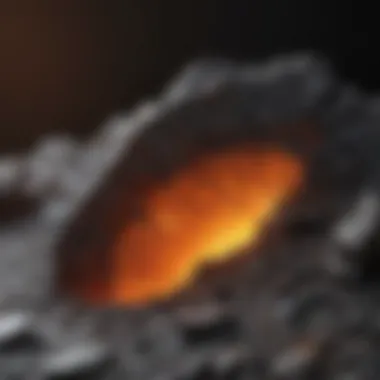
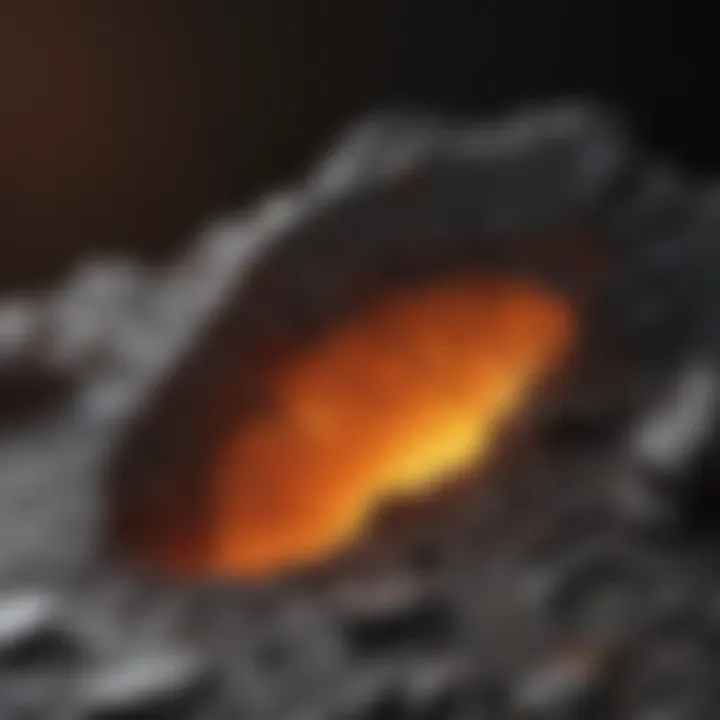
Contribution to Cosmic Understanding
Meteorites are more than scientific curiosities; they help us grasp the cosmic puzzle. Their presence in collections around the world enables detailed comparative studies:
- Characterization of Parent Bodies: By categorizing meteorites into distinct groups based on chemical and isotopic signatures, researchers can infer the characteristics of the bodies from which they originated, whether asteroids or the Moon.
- Solar Nebula Theory: The existence of chondrites, which are the most primitive types of meteorites, supports the notion that these hardened particles formed within the solar nebula. Understanding their composition allows scientists to reconstruct the conditions present in the early solar system.
"Meteorites provide a physical link to the origins of the solar system, revealing the secrets held in their unassuming stony frames."
- Exploration of Other Worlds: The study of meteorites aids in understanding planet-like processes. For instance, findings from Martian meteorites offer insights into the Red Planet's history and conditions, assisting missions aimed at identifying potential habitats for life.
In summary, meteorites facilitate a bridge between humble terrestrial rocks and the far-flung reaches of space. The pursuit of meteorite studies is not merely an academic exercise; it's a quest that frames our understanding of existence itself, a journey through the cosmos that continues to captivate the minds of researchers and collectors alike.
Meteorite Collecting
Meteorite collecting is not just a hobby; it’s a deep dive into the universe itself. For enthusiasts, each chunk of space rock carries with it a history that dates back to the formation of our solar system. Engaging in meteorite collecting connects one with the cosmos in a way that terrestrial materials simply cannot. Understanding the nuances of meteorite collecting, from ethical practices to assessing value, is critical for any serious collector.
Ethical Considerations
Ethical meteorite collecting is paramount. As with many natural resources, it is vital to approach meteorite collecting responsibly. Some key considerations include:
- Legality of Collection: Meteorites differ by country regarding legal frameworks. Make sure to check local laws before embarking on a collection venture. Some nations prohibit the collection of meteorites to protect their scientific value.
- Site Preservation: Collectors must be mindful of the sites from which they collect. Some locations have archaeological significance or bear environmental concerns. Removing a meteorite from such a site can have lasting ramifications.
- Sharing Information: The community thrives on shared knowledge. New collectors should avoid the temptation to hoard information about meteorite locations. Instead, make an effort to contribute to wider understanding and ethical practices in the collector community.
A responsible collector not only respects the law but also honors the stories and scientific potential behind each meteorite.
Evaluating Value
When it comes to evaluating the worth of a meteorite, several factors come into play:
- Type of Meteorite: As previously noted, different classifications of meteorites exist. For instance, stony meteorites typically have a different market value compared to rarer iron meteorites. Understanding the market can help in making informed decisions.
- Provenance: The history of where and how the meteorite was obtained matters. Documented finds can increase a meteorite’s appeal to collectors. A well-documented history can become a story in itself, adding value beyond mere composition.
- Physical Condition: A meteorite's physical state can drastically affect its worth. Specimens that retain their original shape or have a well-preserved fusion crust tend to fetch higher prices. Clear visual appeal counts for a lot in the collector's market.
- Market Demand: Stay updated on trends within the collecting community. What might be abundant today could become scarce tomorrow, affecting value.
"Collecting is not about what you can amass, but what stories you can tell from the fragments you hold."
Being astute about these factors not only aids in developing a valuable collection but also enhances the personal narrative surrounding meteorites.
In summary, meteorite collecting encapsulates a blend of passion, ethics, and knowledge. As collectors navigate through the complexities of ethical practices and assess the value of their specimens, they contribute not just to their personal collections but to the broader understanding of these celestial curiosities.
Challenges in Identification
Identifying meteorites can be a fascinating yet daunting task for enthusiasts and collectors alike. While the allure of owning a piece of a cosmic visitor is strong, the path to accurately determining whether a rock is indeed a meteorite or merely a terrestrial counterpart involves a minefield of challenges. This section dives into the intrinsic difficulties surrounding meteorite identification, unpacking the specific elements that contribute to misidentification and how such dilemmas can be effectively navigated.
Similarities with Terrestrial Rocks
One of the primary hurdles in meteorite identification is the confusing similarities between meteorites and common terrestrial rocks. Many folks with a passion for rock collecting could easily mistake a meteorite for just another inconspicuous stone found in the backyard. For instance, certain basaltic or volcanic rocks can mimic the dark exterior of some meteorites, presenting a real challenge for amateurs.
- Textural resemblances: The textures of basalt and some stony meteorites can often appear indistinguishable, particularly to the naked eye. When considering certain classifications, the lines become blurry.
- Color overlaps: Both terrestrial and extraterrestrial rocks can feature a variety of colors, unknowingly leading enthusiasts down the rabbit hole of misidentification. Reddish hues might suggest terrestrial minerals while gray tones are commonly spotted in meteorites — it's a classic case of deceptive appearances.
- Mineral compositions: Many minerals found in Earthly rocks duplicate the makeup found within meteorites. Take olivine, for example; it’s a common mineral that straddles the line between both worlds.
Moreover, the environmental factors affecting these stones can further complicate the picture. Over time, terrestrial rocks may weather and alter, mimicking meteorite features, making them look like they've just dropped from the great beyond. Therefore, understanding these similarities is crucial for anyone attempting to distinguish a meteorite from a mere imposter.
Misclassification Issues
Beyond the superficial similarities to terrestrial rocks, misclassification often stems from overlooking finer details that show how unique meteorites truly are. These hidden cues, if disregarded, may lead collectors to incorrectly label common Earth rocks as meteorites, which can mislead both the collector and potential buyers.
- Magnetic properties: A significant number of meteorites contain iron and nickel, leading them to exhibit magnetic properties that terrestrial rocks typically do not. However, not every iron-bearing rock will automatically be a meteorite. Learning to measure and interpret magnetic responses accurately is an essential skill for any collector.
- Fusion crust analysis: The ablation process that meteorites undergo as they plummet through the atmosphere results in a characteristic fusion crust. This thin, shiny coating is a key identifier, but without careful inspection, it can easily be overlooked, especially if the rock is partially weathered.
- Chondrules: Some meteorites, especially chondrites, boast tiny spherical inclusions called chondrules. These are difficult to spot without magnification and can easily be mistaken for similar features in volcanic rocks or earthy sediments.
"The excitement of finding what might be a meteorite is rivaled only by the checks and balances required to confirm its authenticity."
Understanding these challenges not only sharpens the skills of collectors but also deepens the appreciation for these celestial wonders.
Finale
Key Takeaways
- Identification Skills: The nuances in textures, colors, and composition can help differentiate meteorites from ordinary terrestrial rocks. An understanding of visual cues, such as fusion crusts and internal structures, is imperative for accurate identification.
- Significance in Research: Meteorites are not just artifacts; they are portals to understanding the universe. They contain evidence of the early solar system and can provide insights into planetary formation processes.
- Collecting Ethics: An appreciation of the ethical considerations surrounding meteorite collection enhances responsible practices within the community, ensuring that collecting efforts are sustainable and respectful to scientific study.
"The uniqueness of each meteorite tells a tale of its journey—understanding these stories elevates our connection to the universe."
Future of Meteorite Research
The exploration of meteorite appearance and its implications is a blossoming field of study. As technology advances, so too does the capacity for detailed analysis of meteorite samples. Spectroscopy, for instance, is increasingly employed to decode the mineral composition without causing any damage to rare specimens. The future may hold the following possibilities:
- Enhanced Analytical Techniques: Further development of high-resolution imaging and chemical analysis will broaden our understanding of the diverse types of meteorites. These methodologies might allow scientists to pinpoint origins more specifically, revealing more about the solar system's formation.
- Citizen Science Initiatives: Engaging the public in identifying and collecting meteorite samples could foster a passionate community that contributes to scientific research. Platforms for sharing findings could encourage broader participation, turning casual enthusiasts into valuable contributors to the field.
- Interdisciplinary Collaboration: The future may see more collaboration between astronomers, geologists, and even artists. This melding of disciplines can lead to new insights, encouraging a comprehensive understanding of meteorites that transcends traditional boundaries.
The path ahead in meteorite research looks promising, ripe with opportunities to expand our cosmic literacy and deepen our appreciation for these otherworldly visitors.



